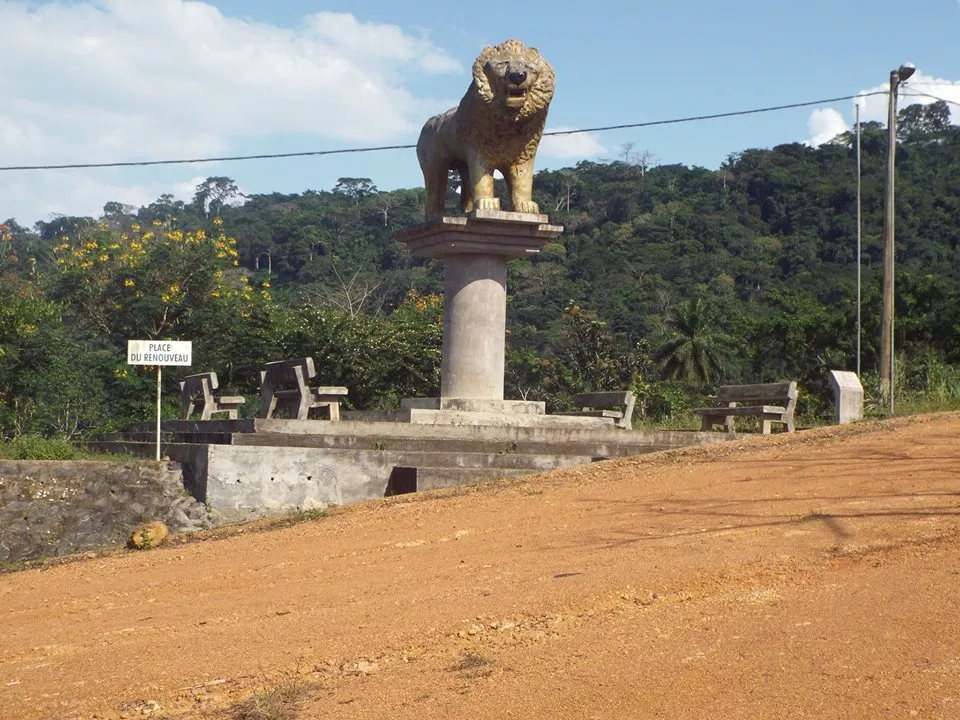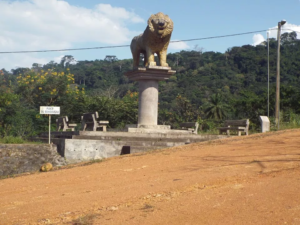The Banen Region: Yingui

BIOPHYSICAL DATA
The climate
The climate of the borough of YINGUI, is characterized by a high rainfall. It is straddling two types of climatic influences: The monsoon of the coast and the equatorial climate. In a simple way, it is subdivided into four seasons which are:
– A long dry season, from December to mid-March;
– A short rainy season from mid-March to mid-May;
– A short dry season from mid-May to mid-July;
-A large rainy season from mid-July to mid-November.

The relief
The relief of YINGUI is very picturesque and presents a rather varied geomorphology. In the north there is a fairly rugged terrain, consisting of hills, raised plateaus and shallow valleys. In the South, the relief consists of meadows and plateaus. The town of YINGUI is located in the transition zone between the South Cameroon Plateau which covers most of the area, the extreme advance of the coastal plains and the southern fallout of the western highlands.
The Soils
Soils are part of the South Cameroon Plateau; these are generally ferralitic clay soils. The humeral layer is very thin, deep, red-brown and very fertile. Two main groups of soils are distinguished:
-The red ferralitic soils;
-The yellow ferralitic soils on the residual trays upstream of the slopes.
The vegetation
NKAM is part of the large South Ecological Forest Zone, which covers the Central, Eastern, Littoral, South and South-West regions and encompasses the entire so-called maritime zone and the equatorial zone. It is characterized by its fairly dense vegetation. It is a forest-savanna contact zone. In the east, peri-forest savanna and hydrophilic forest are found in the west, covering ¾ of the surface. It comes in two aspects which are: The secondary forest marked by the presence of man. Primary forest characterized by its undergrowth. This plant cover is a dense forest of valuable tree species, such as: Sapelli, Sipo, Doussié and Ebène, very popular on the national and international markets. Other wood species, of lesser commercial value, are simply used by man for his daily use. The peri-forest savannah occupies a small area which is becoming smaller due to the creation of plantations. This savannah is shrubby in areas heavily cultivated by the population.
Wildlife
In-village surveys have revealed an abundant and diverse fauna that corresponds to that of savanna and forest ecosystems. The species identified are: buffaloes, hinds, antelopes, gazelles, monkeys, chimpanzees, gorillas, hares, porcupines, pangolins. There is also an important aquatic fauna whose main species are: catfish, carp, tilapias, captains.
hydrography
The district of YINGUI also has a vast hydrographic network of which the principal rivers are: MAKOMBE, NEBO, NOUYE, MASSOUK, NIBOUEM, NIKENG, MAKO, NEKEM, HAN LOGLONGO, DIBAMBA BENONOLI, which throw themselves almost all in big rivers such as NKAM, SANAGA and DIBAMBA. These rivers abound with many species of fish.
DEMOGRAPHIC DATA
Historical profile
The BANEN tribe is the ultra-majority component of the YINGUI district. The BANENs of YINGUI are divided into four (04) large groups, namely the groups: NDIK-BIAKAT; NDIK-TOUNA; NDIK-NANGA; NDICK-BANOL. The NDIK-BANOL are composed of four (04) large families which are: Ndek Tok; Ndek Ndefeli; Ndek Nyok and Ndek Banda. They are found on the north side of the town. The NDIK-TOUNA come from the MBAM AND INOUBOU and precisely the district of NDIKINIMEKI where they migrated to settle in YINGUI. We find them on the south side. The NDIK-BIAKAT also have their origins in the NDIKINIMEKI district. It is a large group but rather scattered throughout the district and mainly in the center. The NDIK-NANGA are descendants of NANGA BOUMEK, son of BOUMEK who also came from NDIKINIMEKI and specifically ETOUNDOU. They are found mostly on the side of SANAGA MARITIME near MASSOK. History reports that the BANEN people, due to multiple migrations in the 17th and 19th centuries, broke up into several clans. These were directed towards the south, the others towards the southwest. BANEN populations are mainly located in three administrative units; NDIKINIMEKI and NITOUKOU in the department of MBAM and INOUBOU and YINGUI in the department of NKAM. Next to this tribe live the NDEM, themselves from a migratory movement that pushed the population of the northern zone of NKAM to the south of this department.
Evolution of the population
For reasons related to the war and the rural exodus, the population of the borough has decreased over the years. By 1933 it was estimated at 15,000 souls. According to the 3rd general census of population and housing in 2005 (3rd RGPH), the population of YINGUI is 2,304 inhabitants, with a sex ratio of 104.70%.
ethnic
The main ethnic groups residing in the municipality are:
The BANEN (majority, which alone cover four cantons),
The BASSA,
NDEM,
NYOKON and other non-native populations come for work reasons.
ECONOMICAL ACTIVITIES
Agriculture, fishing and livestock
The economic activity of the municipality of YINGUI is strongly centered on agriculture with the regrouping of some operators in GIC; the main crops grown are food crops (cassava, plantain, peanut, etc.) and cash crops such as cocoa and oil palm. On the other hand, fishing is not an important economic activity for the inhabitants. Speaking of breeding, it is practiced in a sentimental way (that is to say that the populations develop a deep sympathy with the animals that they raise, as for pets so much that to sell or consume them becomes very difficult, so they prefer to keep them until their often natural death, hence the consecrated expression of “sentimental breeding”). Indeed, although potentially promising, livestock farming is not a priority activity for residents of the municipality; there are some small traditional poultry and pork farms on a very small scale. Other activities include small businesses; motorcycle transport inside the city; Forest explotation.
Trade
It occupies a preponderant place in the local economy. The food trade is the largest activity, followed by general trade. The drinking establishments are a fairly flourishing activity of the city.
crafts
We regret the lack of SMEs / SMIs and crafts in Yingui. In reality, it is the reign of self-help. Paradoxically, we still find people who have the know-how, craftsmanship likely to be developed. It should be noted that in the past Yingui handicrafts were: spoons, forks, ladles, armchairs, all made of wood, ropes for climbing on the palm tree, tom-toms, baskets (wickerwork), raffia armchair coverings, hardwood balls (hikeng).
employment
The informal sector is growing, offering the greatest number of opportunities in terms of informal employment. It integrates all actors of resourcefulness (shoe repair, restoration, hairdressing, sewing, repair of vehicles, masonry). The municipality of YINGUI has been building bridges on its main road (Departmental No. 16). Although it is difficult to establish the exact number of jobs created in this context, access to employment remains difficult. The difficulties of access to credit and the lack of a strategy to create income-generating activities are problems that the municipality will have to tackle to create a new economic environment that can generate jobs.
Transportation
The town is crossed by a main road in land (Departmental No. 16). It does not have a bus station. Inside the city, people move with taxicab bikes that work only occasionally. It should be noted, however, that the motorcycle taxi is a mode of transport that is becoming more and more important in the city. There are also bush cars that work occasionally. They are highly depreciated vehicles that transport goods and people in rather deplorable conditions.
Housing, tourism and hospitality
The habitat in YINGUI is mainly in temporary materials (planks). There is no real urbanization plan, let alone a sanitation policy. There is no hotel in YINGUI. We still note the construction work of a private hotel in
the administrative center. For the time being, tourist activity is not developed. There is still a lack of infrastructure and facilities to attract visitors to YINGUI. By way of illustration, there is only one place of accommodation which happens to be a relatively comfortable hostel.
MAIN INFRASTRUCTURE BY SECTOR
-Health facilities: The commune of YINGUI has a Medical Center
District (CMA) in the city and a health center in IBOTI.
-Education infrastructures: YINGUI commune has one (01) inspection
Basic education; nine (09) primary schools (public and faith-based); a
– (01) SAR-MS; one (01) general education high school and one (01) non-functional CETIC.
-The networks; there is an electrical network not connected to AES / SONEL; this power grid is powered by two generators that frequently break down, hence the darkness that usually prevails in the city. The water supply network has not worked for a very long time.
Telecommunication: the CAMTEL, Orange telephone networks are absent. Only
MTN is present within the urban space. There is also the presence of a desk
PTT (Post and Telecommunication)
-The roads: the entire road network of the municipality consists of roads in
Land, passable in the dry season and almost impassable during the rainy season.
